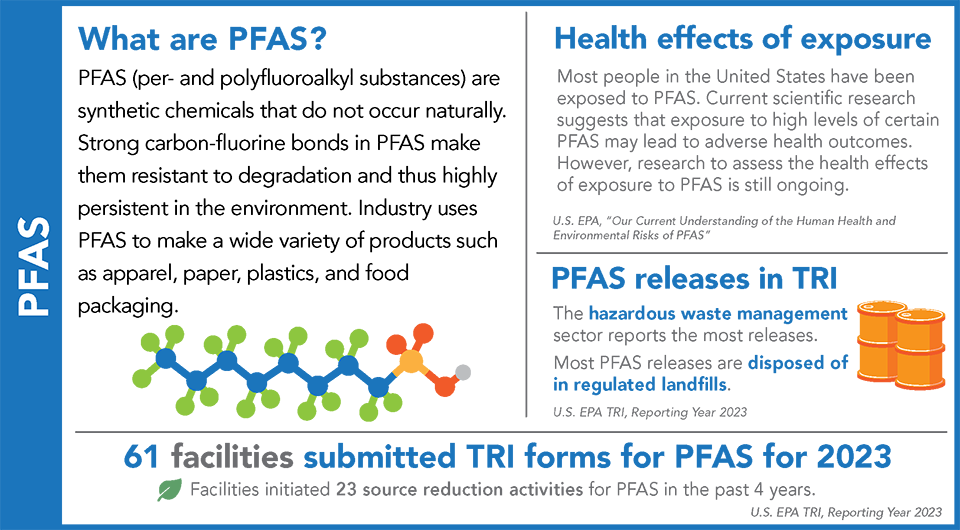PFAS
The TRI chemical list for reporting year 2023 includes 189 per- and polyfluoroalkyl substances (PFAS). Each year, the TRI Program reviews newly available information and adds PFAS to the TRI chemical list if they meet certain criteria.

Facilities reported their releases and other waste management practices for these PFAS for the first time for 2020. Additional PFAS have been added to the list for each subsequent reporting year. The TRI reporting threshold for PFAS is 100 pounds, which is lower than the thresholds for most TRI chemicals. PFAS were also recently designated as chemicals of special concern, which changes certain reporting requirements beginning in 2024.
Note that definitions of which chemicals are considered PFAS vary, and that the PFAS on the TRI chemical list do not include all known per- and polyfluoroalkyl substances. See EPA’s PFAS Explained page for more information about these chemicals and EPA actions related to PFAS.
This map shows the locations of the facilities that reported a PFAS to TRI for 2023, sized by their relative release quantities. Click on a facility for more details on its reporting.
Click on any one of the locations on the map to see detailed information.
View Larger Map
This chart shows the number of facilities in each sector reporting any of the 189 PFAS for 2023.
- Most facilities reporting PFAS were in the chemical manufacturing sector or the hazardous waste management sector.
- Facilities have reported 69 different PFAS since they were first included on the TRI chemical list in 2020. The most-reported PFAS from 2020-2023 were perfluorooctanoic acid (PFOA), perfluorooctane sulfonic acid (PFOS), and hexafluoropropylene oxide dimer acid (HFPO-DA).
PFAS Waste Management
This chart shows how facilities managed PFAS waste. For more details on quantities released, toggle to the “Releases only” figure.
- The quantity of PFAS reported as managed as waste increased by 740,000 pounds from 2020 to 2023.
- 17 PFAS have been added to the TRI reporting list since 2020. In 2023, these PFAS accounted for 7% of total PFAS waste managed.
- Each year, combined quantities of hexafluoropropylene oxide dimer acid (HFPO-DA) and its ammonium salt accounted for more waste managed than any other PFAS.
- The chemical manufacturing and hazardous waste management sectors have reported managing the most PFAS waste each year.
- Since 2020, over half of PFAS waste is reported as treated. Facilities reported a wide range of treatment methods for waste streams containing PFAS including absorption, neutralization, and sludge treatment. Note that TRI requires facilities to report all waste treatment methods applied on site to waste streams that contain the reported chemical, regardless of whether the reported chemical is destroyed by the method.
This chart shows PFAS releases by environmental medium.
- PFAS wastes were primarily disposed of to land. Most (95%) on-site land disposal is to RCRA Subtitle C landfills, which are authorized under the Resource Conservation and Recovery Act (RCRA) to accept hazardous waste.
- After 2020, newly-added PFAS only accounted for only a small portion of releases each year.
- The hazardous waste management sector reported 82% of all PFAS releases for 2023.
This page was published in August 2025 and uses the 2023 TRI National Analysis dataset made public in TRI Explorer in October 2024.
